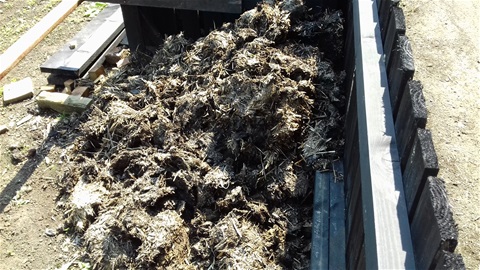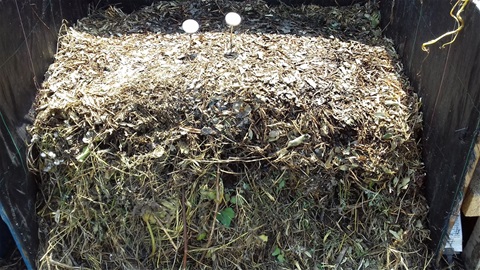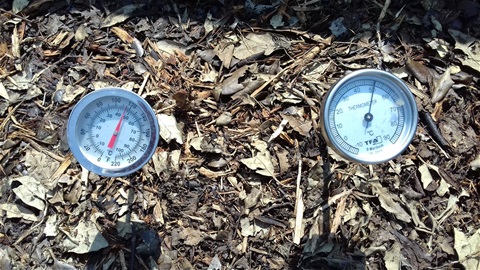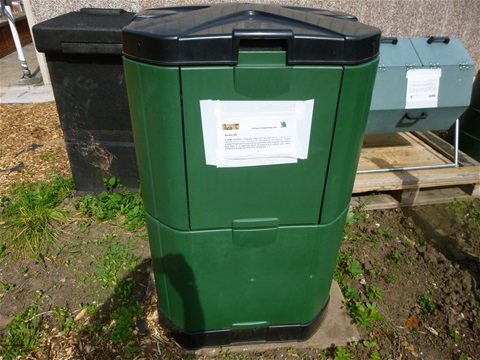Composting Manure
Animal manures have been composted for use in agriculture since the early days of farming using dung from whatever animals were being farmed. (Compost history) Manure from a farmyard or animal pens will also include urine, which has a high nitrogen content, and the soiled carbon rich. bedding e.g. straw. Incorporating manure into the soil is an effective way of replenishing the organic content and creating humus. Adding manure, or other humus rich organic material such as garden compost to the soil increases the biodiversity, and nutrients trace elements help improve the soil structure. This is as important as the provision of N-P-K to the soil but is often overlooked.
According to the Rodale Guide to Composting (1979) manure was considered to be the most important single ingredient in the compost heap, and few heaps did not include at least a layer of manure. The use of manure has fallen out of fashion in home composting possibly as the emphasis of domestic composting has moved from converting garden waste, from a large garden or allotment, into produce a soil enhancer to composting household, kitchen and waste from much smaller gardens garden for environmental reasons such as reducing waste sent to landfill or reducing greenhouse gases.
Herbivores. (grass grazing animals) such as cows, horses and sheep, llamas, goats together with pets such as rabbits, hamsters and guinea pigs, produce nitrogen-rich manure that provides a good source of Greens and can be added as a layer manure layer in a compost bin. Herbivore manures compost quite quickly, often in 12 weeks or less in a conventional metre square pallet bin. They contain a different balance of bacteria species than the faeces of omnivores and carnivore and are less likely to contain as many human pathogens. Manure from sheep, cows, rabbits, llamas, goats, hamsters, etc. are good “green” compost components having a high in nitrogen and aerobic bacteria. When added to a compost bin the manure should be balanced by the addition of carbon rich Browns.
Manures make a good activator if added to a bin being used for garden or household waste:
- as an addition layer when filling a layered bin,
- it can also be added as an additional activator when turning (aerating) a New Zealand bin
- or added and stirred into a Dalek style cool composting bin
The values of manure and organic fertilizers in general, are often based on the relative amount of nitrogen (N), phosphoric acid (P) and potash (K) they contain. However, they are at least as valuable to the gardener as a source of organic matter. Some common types of manure compare as follows (in N/P/K terms):
| Manure | % N | % P | % K |
| Cow | 0.6 | 0.2 |
0.5 |
| Horse. | 0.7 | 0.3 | 0.6 |
| Steer | 0.7 | 0.3 |
0.4 |
| Sheep | 0.7 | 0.3 | 0.9 |
| Pig | 0.5 | 0.3 | 0.5 |
| Chicken | 1.1 | 0.8 | 0.5 |
| Rabbit | 2.4 | 1.4 | 0.6 |
Source: Rodale Guide to Composting
Manure Fresh (Raw) or Rotted?
Manure purchased direct from the farm is unlikely to have been stored and allowed to rot and while it may be tempting to use, it rather than store it in the garden, there are disadvantages.
Raw (fresh) manure can burn plants with which it makes contact and there is a risk of transferring pathogens e.g. E.coli, Salmonella sp. from the manure to the surfaces of plants that are to be eaten. Some allotment plot holders apply fresh manure to an empty dug plot in the autumn and allow it to mature in situ over the winter relying on the worms to take it underground. Others may dig it in to the soil and leave it to overwinter. If succession growing and the plot is not being left empty over winter the manure should be applied at least 30 days before planting . Another disadvantage of spreading fresh manure on a plot is that it is likely to have an unpleasant smell and while this may not be a problem when it is spread on fields, unless you live next to them, it is not welcome in a modern flower garden surrounding the houses.
Most gardeners will probably keep the manure for at least a year before adding it to the soil. Rotted manure, if stored covered to prevent rainwater, will have lost moisture as thus have a higher nutrient level per ton.
However, when farm animals, or horses, are kept on the property there is a danger that so much manure will be produced that the compost heap becomes the manure heap unless it is composted separately.
The value of the manure from farm and domestic animals will vary with the type of animal, the age of the animal and the food on which it was fed. The value of the manure to the gardening will also depends age of the manure and the way in which it has been handled and stored.
Animal manures
Cow Manure
Cow manure is probably the most frequently used of the above manures. Cow dung is high in organic materials and rich in nutrients. Composting the manure before use reduces or eliminates the release of ammonia and pathogens (such. as E. coli or Salmonella). Hot composting will reduce or eliminates weed seeds and kill their roots. Using composted cow manure produces about a third less greenhouse gases than using raw manure to fertilise the soil.
Horse manure
Warning: 2009/10 following problems products containing aminopyralid were temporarily withdrawn from supply, sale and use follow damage to crops grown following treatment with contaminate manure. Following investigation, new approvals were given by the HSE. Measures have been taken to ensure the risk of contaminated manure becoming available to gardeners have been reduced. The advice is that manure should not be accepted from sources that cannot give assurances that the manure has not come from animals fed on grass or forage treated with persistent hormonal weed killers, especially aminopyralid products.
Horse manure has a higher nitrogen content than other farm animal manures making it more valuable to the composter but the concern over pesticide contamination may have added a concern over its use. Manures high in nitrogen rich Greens are prone to fermentation and may be referred to as hot manures whereas those wetter manures with a lower nitrogen content which ferment more slowly may be referred to as cold manures. Manure is from horses usually contains viable weed seeds, to avoid the seeds surviving the composting process hot composting of horse manure is recommended. If cool composting must be used the ground where the compost is spread may need additional hoeing.
Horse manure composts easily, provided it does not dry out. If using a hot composting system where, tuning is a necessary to the composting process, wetting the material when aerating is advised. Ideally based on a scrunch test or moisture level reading. If taken from the stable the manure may include significant amounts of wood chips and straw (browns) as well as urine.
A three or four bin system is probably advisable if horses are kept on the property as each horse will produce approximately 22kg of manure and about 34litre of urine per day to which must be added the bedding. This will enable hot composting of the manure .
Sheep manure
Sheep produce a relatively rich dry manure that has the advantage not being as smelly as some other manures. The same composting techniques can be used for Composting Sheep Manure as for cow manure.
Goat manure
Goat manure can be composted as with other manures and can also be used as mulch. manure from cows or horses. Like sheep manure goat manure is low odour and some gardeners broadcast pellets directly onto the soil.
The goat dung can be added as a layer in a pallet bin or added and mixed with other materials in a Dalek bin. The pelleted manure aids airflow within the bin as does not form a matt as cow dung can.
Alpaca & Llama manure
Alpaca and llama manure is lower in organic matter content than the manure from most other farm animals and the pellets can be spread directly onto the soil without burning the plants. However, in my view it is best allowed to mature and then composted.
If composting, in an entry level bin, such as a dalek, are best mixed with other organic material to improve porosity and air flow. Small quantities of pellets can be added to the contents already in the bin and mixed with an aerator or hand fork. If significant quantities are to be added it is best to mix them with a bulking agent before adding to the bin. This can easily be done on a sheet of tarpaulin.
If operating on a larger scale using a layered composting system e.g., in a pallet or other wooden bin, the alpaca pellets
can be added as one or more separate layers between other greens and browns.
Pig manure
When I was a boy in Sussex in the 1950s it was not unusual for a householder to keep a pig in their garden as an additional source of meat. The manure was not usually composted but was dug into the garden soil in the autumn to decompose over the winter for the next spring’s crops. Pin manure is best hot composted in systems that are turned regularly during the early stages.
Chicken manure
Hens may be kept on the allotment and at home making a regular supply of fresh manure readily available to the home composter. Chicken manure (usually including woodchip or sawdust and/or straw from the bedding) can be used in a layered composting system such as the Indore method or as a layer into a Dalek or tumbler bin which can then be mixed with the other content.
Chicken manure is high in nitrogen and also contains a good amount of phosphorus potassium. It has had a bad reputation in the past as if applied fresh it would burn plants compost overcomes that problem at it should be recognised by the home composter as a valuable resource. It also had a reputation of smelling and while this may be true of deep litter chicken houses in which the build-up of faeces and bedding led to high levels of ammonia. It will not be true of small garden and allotment chicken houses which will be cleaned out much more frequently with the manure being covered when stored and being composted
Rabbit and Guinea pig, Gerbil, and hamster manure.
The manure from small domestic vegetarian pets can be added to the compost heap in the same way as with other herbivore manures although there is likely to significantly less manure. However, the bedding should be compostable and while there may be insufficient bedding and faeces to make frequent manure layers in a New Zealand or pallet bin it can be added to another manure layer mixed with greens . The material can be added and mixed with the normal waste in a Dalek type bin. of manure layer in a pallet bin.
Carnivore manure
It is not generally recommended to home compost faecal waste from meat eating animals e.g. from cats, dogs and snakes is may contain potentially pathogen organisms but there are some methods available that can be used . For more details click the link Dog & Cat Poo
Manure as an addition to a conventional compost heap
Traditionally manure was added to the compost bin or heap in layers when using the Indore method of hot composting or systems based on the Indore system. (Hot Composting )
The Indore method uses alternating layers of vegetable material (mixed greens and browns) and manure to fill a bin of a minimum size of 3 feet square and of about 4 or 5 feet high. The base layer would normally consist of a 3-inch layer of dry organic material followed by a layer of manure approximately two inches deep. This is followed by a further layer of dry organic material with alternating layers continuing until the material is about four foot high. Each layer should be watered when it has been added. Traditionally the material would be covered with a layer of soil.
The composting material should be turned every 3 days adding water if it shows signs of drying out. Alternatively, the temperature of the heap should be monitored it should be in the range of 450C -700C . If it falls below 450C it should be turned by moving to the next bin. If the pile is getting too hot (over 650C -700C) it should be turned as higher temperatures will kill the composting microbes. The compost is transferred to the final bin to mature when it ceases to show any change in temperature and is dark brown in colour, has a crumbly texture and a pleasant earthy smell.
A variation on this which makes it easier to achieve better control of the Green : Brown ratio involves adding the greens and browns as separate layers. This is recommended if a non-turn method is being used. On an allotment plot or a large garden, a two or three bin system is recommended with each compost bin 3- 4-foot square pile. Pallet bins are excellent for this purpose.
When cold composting in a Dalek type bin manure can be added and mixed with the decomposing material in the bin. Additional manure can be added when aerating the compost provided it is balanced with the addition of carbon rich Browns such as straw, hay or cardboard. The addition of manure is particularly useful in a dry period if there is a shortage of fresh green plant material.
Variation for horse manure and bedding mix
The Indore method can be varied to provide a system developed for a manure containing significant amounts of bedding. A base layer of twigs etc. is used as a base level followed by layering 1" of green garden waste including lawn clippings with 3" of horse manure/bedding. Any soft greens from the garden can be mixed in this layer. Bedding soaked with urine will contain its own nitrogen rich activator. If the manure contains significant amounts of bedding the thickness of the green layer should be increased. Turning weekly over the first month is advantageous as it should speed up decomposition and prevent the risk of anaerobic areas in the bin producing greenhouse gases.
Manures in an Aerobin Composter
Aerobin make specific recommendation as to the use of manures in their composters and distinguish between mature and fresh manures.
Mature Cow and Horse manure
A mix of 3 parts manure : 1-part dried leaves is recommended. In other recipes they use woodchip as an alternative to dried leaves
Fresh Cow manure:
1 part cow manure : 1 part wood chips or loose dried leaves.
Sheep manure:
1 part sheep manure :1 part wood chips or dried leaves.
Stable manure:
3 parts stable manure: 1-part fresh leaves and 1 part scrunched or shredded cardboard.
Chicken manure:
Mix 1 part chicken manure : 1 part paper and cardboard: 3 parts fresh leaves.
I have also used small amounts of mature cow manure as part of the general green waste to give the bin a boost.
Manure Liquid Feeds
Manure was commonly soaked to make liquid feeds but these are less popular now due to the risk of contamination by pathogens such as Salmonella




Joseph
can i use dog manure in compost and mulching leaves?
Kate
Should I use fresh or mature horse manure for a hot compost?
Kate
What are the carbon/nitrogen values of horse bedding made from wood shavings?